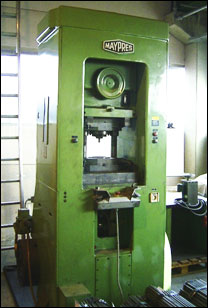Cold Extrusion
The process of cold extrusion is carried out at room temperature or at marginally elevated temperature, with the assistance of Extruder and Extrusion Machines. These equipment / machines are specially developed on the basis of innovative Extrusion Technology. Cold extrusion can also be defined as the process of shaping of a cold metal by striking a slug. This striking is done with a punch (in closed cavity), which forces the metal in upward direction around the punch. This process is also called Cold Forging, Cold Pressing, Extrusion Pressing, and Impact Extrusion.
 Another Definition of Cold Extrusion Another Definition of Cold Extrusion
Cold extrusion is also defined as a compressive forming process (push-through), where the starting material is billet / slug and the process is carried out at the room temperature. During the cold extrusion process, deformation heating of the deforming material takes place at several hundred degrees. Deformation heating is the process of conversion of deformation work to heat. In general, a punch is used for applying pressure to the enclosed billet in the stationary die. This pressure can applied partially or completely, as per the requirements. On the basis of punch, die design along with the resulting material flow, we can classify cold extrusion into three major processes:
• Forward Extrusion
• Backward Extrusion
• Lateral Extrusion.
Forward Extrusion: In this process, the material flows in the direction of the punch displacement. Also, the rod / tube diameter is reduced by forcing it in a die, through an orifice. A variation of this process is known as Hooker Extrusion. In this process, a billet (tubular) is forced by way of a forward extrusion die. This force is applied with a punch and a mandrel that act as a pusher and reduces the outer diameter along with elongating the tubular portion, respectively.
Backward Extrusion: In this process, the material flows in the other direction of the punch displacement. The billet, which is enclosed in die, is forced to flow in the backward direction from the annular region that resides amidst the die and punch.
Lateral Extrusion: In this process, the material flows in the perpendicular direction of the punch displacement. The material, which is enclosed by the punch and die, is forced to flow through orifices that are radially placed.
Advantages & Disadvantages of Cold Extrusion
Cold extrusion is highly advantageous as it is used to withstand all the stresses that are created by the extrusion process. There are various advantages of cold extrusion over the hot extrusion, some of the important ones are listed below:
- No oxidation process
- Higher strength due to cold working
- Good mechanical properties that are provided the temperatures created, are below the re-crystallization temperature
- Closer tolerances
- Good surface finish
- Fast extrusion speeds, in case the material is subjected to hot shortness
Dimensional precision
- Net-shaped features
- Lower energy consumption
- Higher production rates
- Cleaner work environment.
Apart from the above-mentioned advantages, there are some disadvantages as well that are associated with cold extrusion. These are lubrication cost, higher loads, limited shape complexity, and limited deformation.
Applications of Cold Extrusion
- The cold extrusion process is widely used to manufacture products from Copper, Lead, Tin, Aluminum Alloys, Titanium, Molybdenum, Vanadium, Steel, Zirconium, and Niobium.
- Some of the products that are developed using this process include various parts such as Collapsible Tubes, Gear Blanks, Aluminum Cans, Cylinders, Fire Extinguisher Cases, Shock Absorber Cylinders, and Automotive Pistons.
- Cold Extrusion is also used in the Automobile Sector, in various applications such as:
- Injection technology
- Engine control
- Fuel supply
- Automatic transmissions
- Seat technology
- Safety systems (restraint systems)
|
|